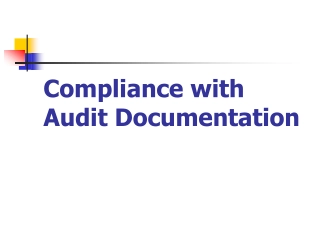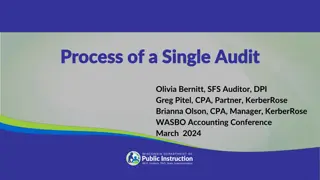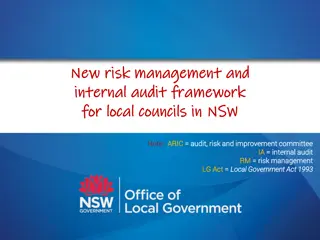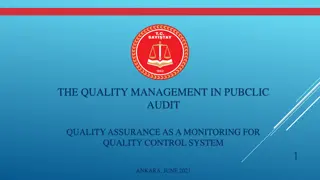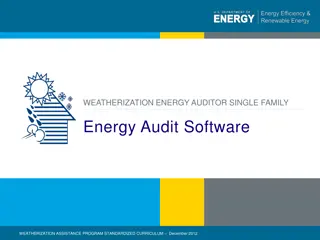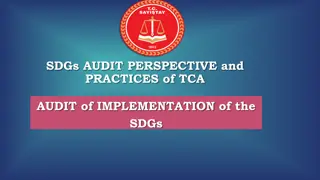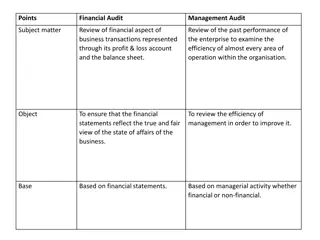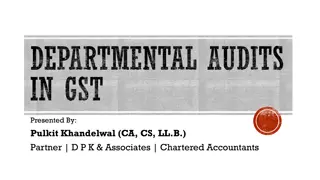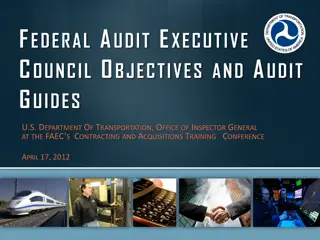
Insights into Zambia's Recent Prison Audit: Findings & Legal Framework
Explore the background, purpose, objectives, methodology, and legal framework of Zambia's second prison audit conducted in 2022. Discover the key findings and the nexus between the audit results and the National Prosecution Authority (NPA).
Download Presentation

Please find below an Image/Link to download the presentation.
The content on the website is provided AS IS for your information and personal use only. It may not be sold, licensed, or shared on other websites without obtaining consent from the author. If you encounter any issues during the download, it is possible that the publisher has removed the file from their server.
You are allowed to download the files provided on this website for personal or commercial use, subject to the condition that they are used lawfully. All files are the property of their respective owners.
The content on the website is provided AS IS for your information and personal use only. It may not be sold, licensed, or shared on other websites without obtaining consent from the author.
E N D
Presentation Transcript
OUTLINE Background Purpose Objectives Methodology Legal Framework Findings Connection Between Prison Audit Findings and the NPA
BACKGROUND Second prison audit (first was conducted 14 years ago) Jointly launched in November 2022 by the Minister of Justice and the Minister of Home Affairs and Internal Security The data collection team comprised of representatives from various institutions including the ZCS, ZP, Judiciary, LAB and CSOs such as PAN and PRISCCA
PURPOSE OF THE PRISON AUDIT 1. To assess the conditions of correctional centres 2. To assess the extent of awareness and respect for inmates human rights in the centres 3. To assess the challenges faced by inmates 4. To assess the amnesty procedures available to inmates 5. To assess the extent to which correctional services are implemented and realised following the enactment of the Zambia Correctional Service Act in 2021
OBJECTIVES To address the bottlenecks in the criminal justice system which contribute to overcrowding in correctional centres To improve the respect of inmates human rights To enhance the provision of correctional services , following the enactment of the Zambia. Correctional Service Act in 2021 whose focus is more on rehabilitation than punishment
METHODOLOGY Adopted a mixed-method research approach that gathered both qualitative and quantitative data In-depth investigation and understanding of complex and multiple factors associated with overcrowding in correctional centres in Zambia Out of 87 correctional centres in Zambia, the audit team visited 68 centres: i.e. 52 correctional centres, 10 correctional farms, three remand prisons, two training schools and one reformatory school There were more than 3, 500 participants and respondents in the audit
LEGAL FRAMEWORK Constitutional state (guarantees civil and political rights in the BoRs) CEDAW; ICCPR; ICESCR; ACHRPR; ACRWC; CRC; CAT (standards for detainees) The Nelson Mandela Rules (NMRs) The ZCS Act domesticated the NMRs in 2021 Prison Rules (1966) which govern the day-to-day running of the correctional centres Accommodation Separate accommodation per category- Section 36 ZCS Act & Rule 9(2) Prison Rules Separate beds, mattresses and beddings which are clean - Rule 21 NMRs & Rule 163(3) Prison Rules Access to toilets - No legal provision Bathing and shower installations - Rule 16 NMRs Drinking water points - Rule 22(2) NMRs Adequate ventilation - Rule 13 & Rule 14(a) NMRs
Food and Nutrition: Rule 22 NMRs & Rule 24 Prison Rules Sanitation and Hygiene: Rule 105 Prison Rules Health and Medical Care: Establish healthcare facilities - Section 14 ZCS Act & Rule 24 Prison Rules GRZ to provide healthcare services - Rule 24 of the NMRs Officer in Charge must inform relatives in case of serious illness - Rule 24 NMRs ZCS must take preventive measures (infectious diseases) - Rule 108 Prison Rules Skills Training: education, vocational training, work opportunities, and other forms of support that are suitable and accessible.- Rule 4(2) NMRs
Education: Right to free basic education - Section 15 Education Act Education is also compulsory for all illiterate and young inmates - Rule 104 NMRs All other inmates have the right to part-time education ; mandatory to have a library- Rule 227 Prison Rules Work: Sentenced inmates should be given the opportunity to work and actively participate in their rehabilitation - Rule 96 NMRSs Worship and Religion: Freedom of worship - Article 19 of the Constitution Counselling: Providecomprehensive counselling services for inmates - Section 51 ZCS Act Recreation: offer recreational and cultural pursuits for a minimum of 1hr/day - Rule 105 NMRs Legal Framework = Very Good
FINDINGS Mansa Correctional Center, 2023
Inmates Population = 26,150 as of Mid-May 2023 25000 Held at his Excelences's Pleasure 0.43 19415 20000 Juvenile ordered 0.92 Category of cases Juvenile remandees 1.54 15000 Lifers 2.25 Population Prohibited Immigrants 3.43 10000 Remandees 17.17 Convicts 74.24 4490 0.00 20.00 40.00 60.00 80.00 5000 Percentage 898 589 404 241 113 0 Remandees Convicts Prohibited Immigrants Juvenile remandees Juvenile ordered Held at his Excelences's Pleasure Lifers Categories of inmates
Level of education- 94 % of inmates lack any form of tertiary education Average age at the time of arrest - 31 years The minimum being 12 and maximum 85 years About 50 % did not go beyond primary education, while 44 % had secondary education and about 6 % had attained tertiary education Percentage of inmates by age ranges 50.00 45.56 45.00 40.00 35.00 Level of education 29.41 30.00 Percentage 50 43.9 25.00 45 38.6 40 20.00 35 Percentage 12.94 15.00 30 25 10.00 7.23 20 3.70 5.00 15 11.6 0.99 0.16 0.02 10 0.00 5.9 Below 20 20 -29 30 -39 40 -49 Age category 50 -59 60 -69 70 -79 80 -89 5 0 No formal education Primary Secondary Tertiary Levels of education
Intra-Category Gender Distribution Status of Cases 38.8% of the cases are incomplete, 61.2% are complete 20000 18891 Male Female 18000 Majority among the incomplete =awaiting judgment (40.8%), trial stage (18.5%) and awaiting committal (14.8%) 16000 14000 12000 Population 10000 40.8 45.0 40.0 8000 35.0 30.0 6000 25.0 18.5 Percentage 20.0 14.8 4240 15.0 4000 6.8 5.4 10.0 4.9 3.7 3.3 1.9 5.0 2000 840 0.0 567 524 392 250 238 106 58 22 12 7 3 0 Remadees Convicts Prohibited Immigrants Juveniles ordered Juveniles remendered HEPs Lifers Category of cases Stages of cases
Accommodation All the 68 facilities - overcrowded Ventilation Mainly ranged between poor and fair Dorms had little ventilation, exacerbated conditions of the sick, and increased risk of contracting communicable illnesses especially during the hot season Right: Mwembeshi Correctional Facility Windows and ventilation at
Sleeping Space most of the inmates slept according to their various categories Constraint - limited infrastructure Beds, Mattresses and Beddings beds highly insufficient; few mattresses Only 35% of inmates slept on mattresses; 65% slept on the floor Only 51% of inmates had beddings Sitting Space - General lack of sitting spaces. Seriously, how can inmates have where to sit if a dormitory with the initial capacity for 30 inmates in a cell houses 300 inmates? Male inmate at Ndola Remand Prison No sitting spaces inside and outside dormitories
FOOD AND NUTRITION Is the food ration sufficient? No -71% Nutrition-Dietary diversity Dominance of carbohydrates & proteins, (Beans and Kapenta) Low intake of vegetables (<25%) and meat Poorly cooked especially relish Differential treatment concerning access to food Biased against remandees Circumstantial children Food rationing system insensitive Age Sex Health/medication conditions Number of meals One Two Three 16% 17% 67%
Health Care Services 84% reported access to health facility 57% satisfied with services 55 % of Health Facilities had an isolation ward/lobby Due to congestion and poor sanitation communicable diseases are rampant Dinning Halls - no designated dining halls Kitchen - majority have shift facilities; ill-equipped; inmate are made to cook for themselves on firewood Drinking Water Points No access to adequate, clean and safe drinking water 54% of the facilities had no taps inside the cells and dormitories; while 33% had one tap inside the dormitories and cells The ICRC recommends that for every 100 detainees, there should be 1 2 taps
This toilet is in the same place as the source of drinking water Kabwe Female Maximum Correctional Centre
Sanitation and Hygiene Sanitation - worrisome Hygiene General hygiene is a major challenge; Multipurpose use of space and items No facilities for the proper care of inmates hair Low access to soap, toothpaste and detergents Education Most children do not have access to education; facilities lack educational resources Differential treatment of inmates by the ZCS Shortage of teachers; lack of adequate education infrastructure Skills Training Lack of adequate training equipment, infrastructure and instructors Vocational courses are not taught with an objective to empower inmates but to fulfil ZCS obligation to provide skills training
Work and Farming Inmates work nearly everyday; some from 07:00 16:00 hours, without a break Not remunerated for the work No distinction between simple labour and hard labour No certification to recognise inmates competence to work Worship and Religion 88% of the inmates indicated that all religious groups are allowed in their correctional facilities; 64% have access to worship facilities No infrastructure built specifically for religious activities Inmates were forced to work on weekends Places of worship were not accommodative of the needs of PwDs Female inmates often had no designated place to worship Counselling 70% of the inmates had counselling services on premises Not accessible by all inmates only 60% had usedcounselling services Some inmates were unaware of the existence of the counselling service; some facilities lacked them Recreation 48% of inmates said they took part in a recreational activity 52% of inmates have no access to recreational facilities available to them
Enjoyment of Human Rights Right to practice one's religion 88 Right to beddings 51 Right to food and nutrion 51 Right to mattresses 35 Freedom from inhuman or degrading treatment 32 Right to education 32 Right to safe water and sanitation 32 Freedom from sexual abuse 30 Right to communicate with family and friends 28 Right to be told why you have been arrested 27 Freedom from discrimination 25 Right to be charged 25 Right to complain to authorities on conditions and administrative matters 23 Right to make a phone call 20 Right to suitable and adequate clothing 16 Right to a lawyer from time of arrest onwards 13 Right to be released on bail 13 Right to be released on bond 13 Right to apply for legal aid 12 Right to recreational and cultural activities 12 Right to be brought before court within 24 hours 11 Right to be separated from convicted inmates 11 Right to be realesed on own recognisance 8 0 10 20 30 40 50 60 70 80 90 100
CONNECTION BETWEEN THE PRISON AUDIT FINDINGS AND THE NPA 1. Mandate of NPA = to institute criminal proceedings on behalf of the State Custodian of the key to the flood gates that lead to prison 2. Maintenance of rule of law and protection of human rights (Sec 5(f) NPA Act) Legal Framework = Very Good; Implementation = Very Poor Sleeping like sardines? Using the same bucket to unblock the sewer and store drinking water? Held in remand for years exceeding punishment if found guilty? Circumstantial children? Sexual violation of children? 3. Ensure fairness and effectiveness in prosecutions (Sec 5(g) NPA Act) Is it fair to prosecute a child who has stolen two eggs?
4. Enforce international standards (Sec 5(b) NPA Act) Prosecutors are the essential agents of the administration of justice, and as such should respect and protect human dignity and uphold human rights, thus contribution to ensuring due process and the smooth functioning of the criminal justice system. The prosecutor s role is one of great responsibility. Few positions in society are vested with the authority and responsibility to decide on issues fundamental to the administration of justice. United Nations Office on Drugs and Crime (UNODC), The Status and Role of Prosecutors, 2014, page 1. Pursuit of Prosecutorial Excellence! THE END.

